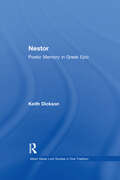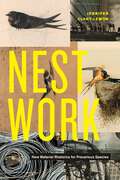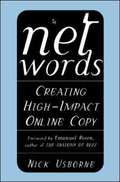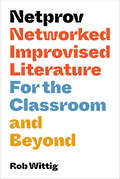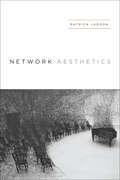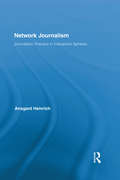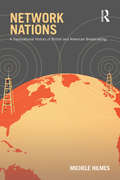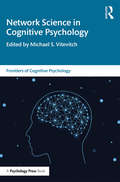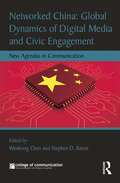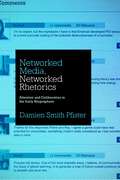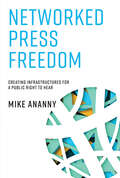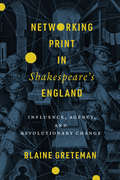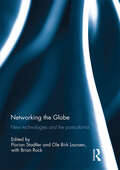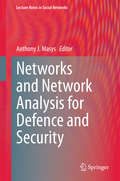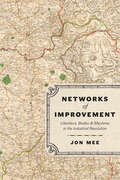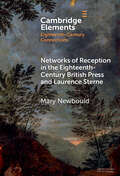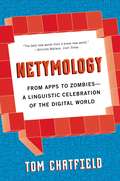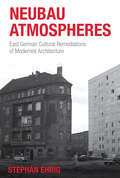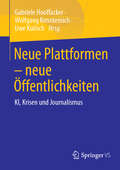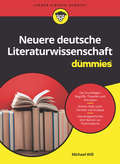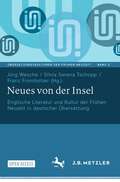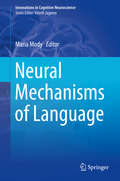- Table View
- List View
Nestor: Poetic Memory in Greek Epic (Albert Bates Lord Studies in Oral Tradition #Vol. 16)
by Keith DicksonFirst published in 1995. Routledge is an imprint of Taylor & Francis, an informa company.
Nestwork: New Material Rhetorics for Precarious Species (RSA Series in Transdisciplinary Rhetoric)
by Jennifer Clary-LemonAs more and more species fall under the threat of extinction, humans are not only taking action to protect critical habitats but are also engaging more directly with species to help mitigate their decline. Through innovative infrastructure design and by changing how we live, humans are becoming more attuned to nonhuman animals and are making efforts to live alongside them.Examining sites of loss, temporal orientations, and infrastructural mitigations, Nestwork blends rhetorical and posthuman sensibilities in service of the ecological care. In this innovative ethnographic study, rhetorician Jennifer Clary-Lemon examines human-nonhuman animal interactions, identifying forms of communication between species and within their material world. Looking in particular at nonhuman species that depend on human development for their habitat, Clary-Lemon examines the cases of the barn swallow, chimney swift, and bobolink. She studies their habitats along with the unique mitigation efforts taken by humans to maintain those habitats, including building “barn swallow gazebos” and artificial chimneys and altering farming practices to allow for nesting and breeding. What she reveals are fascinating forms of rhetoric not expressed through language but circulating between species and materials objects.Nestwork explores what are in essence nonlinguistic and decidedly nonhuman arguments within these local environments. Drawing on new materialist and Indigenous ontologies, the book helps attune our senses to the tragedy of species decline and to a new understanding of home and homemaking.
Net Words: Creating High-Impact Online Copy
by Nick UsborneA practical guide on how to write online text that is funny, personal, engaging, and informative-in short, how to write text that people actually want to read. It gives insight on how to attract customers by online communication.
Netprov: Networked Improvised Literature for the Classroom and Beyond
by Rob WittigNetprov is an emerging interdisciplinary digital art form that offers a literature-based “show” of insightful, healing satire that is as deep as the novels of the past. This accessible history of Netprov emerges out of an ongoing conversation about the changing roles and power dynamics of author and reader in an age of real-time interactivity. Rob Wittig describes a literary genre in which all the world is a platform and all participants are players. Beyond serving as a history of the genre, this book includes tips and examples to help those new to the genre teach and create netprovs. “Jargon-free and ambitious in scope, Netprov meets the needs of several types of readers. Casual readers will be met with straightforward and easy-to-follow definitions and examples. Scholars will find deep wells of in- formation about networked roleplay games. Teachers and students will find instructions for how-to play, and a ready-made academic context to make their play meaningful and memorable.” —Kathi Inman Berens, Portland State University
Network Aesthetics
by Patrick JagodaThe term “network” is now applied to everything from the Internet to terrorist-cell systems. But the word’s ubiquity has also made it a cliché, a concept at once recognizable yet hard to explain. Network Aesthetics, in exploring how popular culture mediates our experience with interconnected life, reveals the network’s role as a way for people to construct and manage their world—and their view of themselves. Each chapter considers how popular media and artistic forms make sense of decentralized network metaphors and infrastructures. Patrick Jagoda first examines narratives from the 1990s and 2000s, including the novel Underworld, the film Syriana, and the television series The Wire, all of which play with network forms to promote reflection on domestic crisis and imperial decline in contemporary America. Jagoda then looks at digital media that are interactive, nonlinear, and dependent on connected audiences to show how recent approaches, such as those in the videogame Journey, open up space for participatory and improvisational thought. Contributing to fields as diverse as literary criticism, digital studies, media theory, and American studies, Network Aesthetics brilliantly demonstrates that, in today’s world, networks are something that can not only be known, but also felt, inhabited, and, crucially, transformed.
Network Journalism: Journalistic Practice in Interactive Spheres (Routledge Research in Journalism)
by Ansgard HeinrichDrawing on current theoretical debates in journalism studies, and grounded in empirical research, Heinrich here analyzes the interplay between journalistic practice and processes of globalization and digitalization. She argues that a new kind of journalism is emerging, characterized by an increasingly global flow of news as well as a growing number of news deliverers. Within this transformed news sphere the roles of journalistic outlets change. They become nodes, arranged in a dense net of information gatherers, producers, and disseminators. The interactive connections among these news providers constitute what Heinrich calls the sphere of "network journalism."
Network Morphology
by Andrew Hippisley Dunstan BrownMorphology is particularly challenging, because it is pervaded by irregularity and idiosyncrasy. This book is a study of word structure using a specific theoretical framework known as 'Network Morphology'. It describes the systems of rules which determine the structure of words by construing irregularity as a matter of degree, using examples from a diverse range of languages and phenomena to illustrate. Many languages share common word building strategies and many diverge in interesting ways. These strategies can be understood by distinguishing different notions of 'default'. The Network Morphology philosophy promotes the use of computational implementation to check theories. The accompanying website provides the computer coded version of the Network Morphology model of word structure for readers to test, customize and develop. This book will be a valuable contribution to the fields of linguistic typology and morphology and will be welcomed by researchers and graduate students in these areas.
Network Nations: A Transnational History of British and American Broadcasting
by Michele HilmesIn Network Nations, Michele Hilmes reveals and re-conceptualizes the roots of media globalization through a historical look at the productive transnational cultural relationship between British and American broadcasting. Though frequently painted as opposites--the British public service tradition contrasting with the American commercial system--in fact they represent two sides of the same coin. Neither could have developed without the constant presence of the other, in terms not only of industry and policy but of aesthetics, culture, and creativity, despite a long history of oppositional rhetoric. Based on primary research in British and American archives, Network Nations argues for a new transnational approach to media history, looking across the traditional national boundaries within which media is studied to encourage an awareness that media globalization has a long and fruitful history. Placing media history in the framework of theories of nationalism and national identity, Hilmes examines critical episodes of transnational interaction between the US and Britain, from radio’s amateurs to the relationship between early network heads; from the development of radio features and drama to television spy shows and miniseries; as each other’s largest suppliers of programming and as competitors on the world stage; and as a network of creative, business, and personal relationships that has rarely been examined, but that shapes television around the world. As the global circuits of television grow and as global regions, particularly Europe, attempt to define a common culture, the historical role played by the British/US media dialogue takes on new significance.
Network Science in Cognitive Psychology (Frontiers of Cognitive Psychology)
by Michael S. VitevitchThis volume provides an integrative review of the emerging and increasing use of network science techniques in cognitive psychology, first developed in mathematics, computer science, sociology, and physics. The first resource on network science for cognitive psychologists in a growing international market, Vitevitch and a team of expert contributors provide a comprehensive and accessible overview of this cutting-edge topic. This innovative guide draws on the three traditional pillars of cognitive psychological research–experimental, computational, and neuroscientific–and incorporates the latest findings from neuroimaging. The network perspective is applied to the fundamental domains of cognitive psychology including memory, language, problem-solving, and learning, as well as creativity and human intelligence, highlighting the insights to be gained through applying network science to a wide range of approaches and topics in cognitive psychology Network Science in Cognitive Psychology will be essential reading for all upper-level cognitive psychology students, psychological researchers interested in using network science in their work, and network scientists interested in investigating questions related to cognition. It will also be useful for early career researchers and students in methodology and related courses.
Networked China: New Agendas in Communication (New Agendas in Communication Series)
by Stephen D. Reese Wenhong ChenThe Internet and digital media have become conduits and locales where millions of Chinese share information and engage in creative expression and social participation. This book takes a cutting-edge look at the impacts and implications of an increasingly networked China. Eleven chapters cover the terrain of a complex social and political environment, revealing how modern China deals with digital media and issues of censorship, online activism, civic life, and global networks. The authors in this collection come from diverse geographical backgrounds and employ methods including ethnography, interview, survey, and digital trace data to reveal the networks that provide the critical components for civic engagement in Chinese society. The Chinese state is a changing, multi-faceted entity, as is the Chinese public that interacts with the new landscape of digital media in adaptive and novel ways. Networked China: Global Dynamics of Digital Media and Civic Engagement situates Chinese internet in its complex, generational context to provide a full and dynamic understanding of contemporary digital media use in China. This volume gives readers new agendas for this study and creates vital new signposts on the way for future research. .
Networked Media, Networked Rhetorics: Attention and Deliberation in the Early Blogosphere (Rhetoric and Democratic Deliberation #10)
by Damien Smith PfisterIn Networked Media, Networked Rhetorics, Damien Pfister explores communicative practices in networked media environments, analyzing, in particular, how the blogosphere has changed the conduct and coverage of public debate. Pfister shows how the late modern imaginary was susceptible to “deliberation traps” related to invention, emotion, and expertise, and how bloggers have played a role in helping contemporary public deliberation evade these traps. Three case studies at the heart of Networked Media, Networked Rhetorics show how new intermediaries, including bloggers, generate publicity, solidarity, and translation in the networked public sphere. Bloggers “flooding the zone” in the wake of Trent Lott’s controversial toast to Strom Thurmond in 2002 demonstrated their ability to invent and circulate novel arguments; the pre-2003 invasion reports from the “Baghdad blogger” illustrated how solidarity is built through affective connections; and the science blog RealClimate continues to serve as a rapid-response site for the translation of expert claims for public audiences. Networked Media, Networked Rhetorics concludes with a bold outline for rhetorical studies after the internet.
Networked Media, Networked Rhetorics: Attention and Deliberation in the Early Blogosphere (Rhetoric and Democratic Deliberation)
by Damien Smith PfisterIn Networked Media, Networked Rhetorics, Damien Pfister explores communicative practices in networked media environments, analyzing, in particular, how the blogosphere has changed the conduct and coverage of public debate. Pfister shows how the late modern imaginary was susceptible to “deliberation traps” related to invention, emotion, and expertise, and how bloggers have played a role in helping contemporary public deliberation evade these traps. Three case studies at the heart of Networked Media, Networked Rhetorics show how new intermediaries, including bloggers, generate publicity, solidarity, and translation in the networked public sphere. Bloggers “flooding the zone” in the wake of Trent Lott’s controversial toast to Strom Thurmond in 2002 demonstrated their ability to invent and circulate novel arguments; the pre-2003 invasion reports from the “Baghdad blogger” illustrated how solidarity is built through affective connections; and the science blog RealClimate continues to serve as a rapid-response site for the translation of expert claims for public audiences. Networked Media, Networked Rhetorics concludes with a bold outline for rhetorical studies after the internet.
Networked Press Freedom: Creating Infrastructures for a Public Right to Hear
by Mike AnannyReimagining press freedom in a networked era: not just a journalist's right to speak but also a public's right to hear. In Networked Press Freedom, Mike Ananny offers a new way to think about freedom of the press in a time when media systems are in fundamental flux. Ananny challenges the idea that press freedom comes only from heroic, lone journalists who speak truth to power. Instead, drawing on journalism studies, institutional sociology, political theory, science and technology studies, and an analysis of ten years of journalism discourse about news and technology, he argues that press freedom emerges from social, technological, institutional, and normative forces that vie for power and fight for visions of democratic life. He shows how dominant, historical ideals of professionalized press freedom often mistook journalistic freedom from constraints for the public's freedom to encounter the rich mix of people and ideas that self-governance requires. Ananny's notion of press freedom ensures not only an individual right to speak, but also a public right to hear. Seeing press freedom as essential for democratic self-governance, Ananny explores what publics need, what kind of free press they should demand, and how today's press freedom emerges from intertwined collections of humans and machines. If someone says, “The public needs a free press,” Ananny urges us to ask in response, “What kind of public, what kind of freedom, and what kind of press?” Answering these questions shows what robust, self-governing publics need to demand of technologists and journalists alike.
Networking Print in Shakespeare’s England: Influence, Agency, and Revolutionary Change (Stanford Text Technologies)
by Blaine GretemanIn Networking Print in Shakespeare's England, Blaine Greteman uses new analytical tools to examine early English print networks and the systemic changes that reshaped early modern literature, thought, and politics. In early modern England, printed books were a technology that connected people—not only readers and writers, but an increasingly expansive community of printers, publishers, and booksellers—in new ways. By pairing the methods of network analysis with newly available digital archives, Greteman aims to change the way we usually talk about authorship, publication, and print. As Greteman reveals, network analysis of the nearly 500,000 books printed in England before 1800 makes it possible to speak once again of a "print revolution," identifying a sudden tipping point at which the early modern print network became a small world where information could spread in new and powerful ways. Along with providing new insights into canonical literary figures like Milton and Shakespeare, data analysis also uncovers the hidden histories of key figures in this transformation who have been virtually ignored. Both a primer on the power of network analysis and a critical intervention in early modern studies, the book is ultimately an extended meditation on agency and the complexity of action in context.
Networking the Globe: New Technologies and the Postcolonial
by Florian Ole BirkContemporary events which have catastrophic global ramifications such as the current economic crisis or on-going conflicts across the globe are not only mediated by super-fast digital communication and information networks, but also conditioned by the presence of rapidly advancing technologies. From social network sites like YouTube and Facebook to global satellite news channels like Al Jazeera or the BBC World Service, digital forms of culture have multiplied in recent years, creating global conduits and connections which shape our lives in many ways. Bringing together an interdisciplinary group of scholars, this book addresses how new technologies have impacted discussions of identity, place and nation, and how they are shifting the parameters of postcolonial thought. Each chapter reflects on current research in its respective field, and presents new directions on the interconnection between new technologies and the postcolonial in a contemporary context. Offering a major intervention in debates around global networks, this thought-provoking collection highlights innovative research on new technologies, and its impact on a ‘postcolonial’ world. This book was originally published as a special issue of the Journal of Postcolonial Writing.
Networks and Network Analysis for Defence and Security
by Anthony J. MasysNetworks and Network Analysis for Defence and Security discusses relevant theoretical frameworks and applications of network analysis in support of the defence and security domains. This book details real world applications of network analysis to support defence and security. Shocks to regional, national and global systems stemming from natural hazards, acts of armed violence, terrorism and serious and organized crime have significant defence and security implications. Today, nations face an uncertain and complex security landscape in which threats impact/target the physical, social, economic and cyber domains. Threats to national security, such as that against critical infrastructures not only stem from man-made acts but also from natural hazards. Katrina (2005), Fukushima (2011) and Hurricane Sandy (2012) are examples highlighting the vulnerability of critical infrastructures to natural hazards and the crippling effect they have on the social and economic well-being of a community and a nation. With this dynamic and complex threat landscape, network analysis has emerged as a key enabler in supporting defence and security. With the advent of 'big data' and increasing processing power, network analysis can reveal insights with regards to structural and dynamic properties thereby facilitating greater understanding of complex networks, their entities, interdependencies, vulnerabilities to produce insights for creative solutions. This book will be well positioned to inform defence, security and intelligence professionals and researchers with regards to leading methodologies and approaches.
Networks of Improvement: Literature, Bodies, and Machines in the Industrial Revolution
by Jon MeeA new literary-cultural history of the Industrial Revolution in Britain from the late eighteenth to the mid-nineteenth centuries. Working against the stubbornly persistent image of “dark satanic mills,” in many ways so characteristic of literary Romanticism, Jon Mee provides a fresh, revisionary account of the Industrial Revolution as a story of unintended consequences. In Networks of Improvement, Mee reads a wide range of texts—economic, medical, and more conventionally “literary”—with a focus on their circulation through networks and institutions. Mee shows how a project of enlightened liberal reform articulated in Britain’s emerging manufacturing towns led to unexpectedly coercive forms of machine productivity, a pattern that might be seen repeating in the digital technologies of our own time. Instead of treating the Industrial Revolution as Romanticism’s “other,” Mee shows how writing, practices, and institutions emanating from these industrial towns developed a new kind of knowledge economy, one where local literary and philosophical societies served as important transmission hubs for the circulation of knowledge.
Networks of Improvement: Literature, Bodies, and Machines in the Industrial Revolution
by Jon MeeA new literary-cultural history of the Industrial Revolution in Britain from the late eighteenth to the mid-nineteenth centuries. Working against the stubbornly persistent image of “dark satanic mills,” in many ways so characteristic of literary Romanticism, Jon Mee provides a fresh, revisionary account of the Industrial Revolution as a story of unintended consequences. In Networks of Improvement, Mee reads a wide range of texts—economic, medical, and more conventionally “literary”—with a focus on their circulation through networks and institutions. Mee shows how a project of enlightened liberal reform articulated in Britain’s emerging manufacturing towns led to unexpectedly coercive forms of machine productivity, a pattern that might be seen repeating in the digital technologies of our own time. Instead of treating the Industrial Revolution as Romanticism’s “other,” Mee shows how writing, practices, and institutions emanating from these industrial towns developed a new kind of knowledge economy, one where local literary and philosophical societies served as important transmission hubs for the circulation of knowledge.
Networks of Reception in the Eighteenth-Century British Press and Laurence Sterne (Elements in Eighteenth-Century Connections)
by Mary NewbouldCriticism and creativity characterised literary reception in eighteenth-century Britain. The press – periodicals, newspapers, and magazines – harboured the reviewing cultures belonging to the emerging professionalisation of literary criticism. It also provided highly fertile ground for creativity, including imitative items inspired by new publications, while critical reviews often incorporated parody. The press fostered experimentation among often anonymous reader-contributors, even while it facilitated the establishment of 'classic' works by recirculating well-known authors' names. Laurence Sterne's reception was energetically shaped by the interaction between critical and creative responses: the press played a major role in forging his status as an 'inimitable' author of note.
Netymology: A Linguistic Celebration of the Digital World
by Tom ChatfieldComposed of 100 bite-sized entries of 400 to 600 words each, Netymology weaves together stories, etymologies and analyses around digital culture's transformation and vocabulary. Chatfield presents a kaleidoscopic, thought-provoking tour through the buried roots of the symbols, speech, and mannerisms we have inherited from the digital age: from the @ and Apple symbols, to HTML and Trojan horses, to the twisted histories of new forms of slang, memes, text messages and gaming terms; how language itself is being shaped by technology, how it is changing us.
Neubau Atmospheres: East German Cultural Remediations of Modernist Architecture
by Stephan EhrigThe artistic potential modern, urban housing (“Neubau”) offered to writers and directors in East Germany from the 1960s to 1980s remains underexplored. Neubau Atmospheres seeks to bridge that gap by providing an incisive analysis of East German cinematic, literary, and architectural case studies, highlighting how the modernist housing of the GDR provided a potent vehicle for mediating the emotional and social experience of its denizens. Considering how these cinematic and literary representations focalized ideas of class, gender, and age, author Stephan Ehrig makes a compelling case for viewing this engagement with the urban environment as a cultural genre in its own right.
Neue Plattformen – neue Öffentlichkeiten: KI, Krisen und Journalismus
by Gabriele Hooffacker Wolfgang Kenntemich Uwe KulischAlgorithmen und Künstliche Intelligenz wie die generative Sprach-KI ChatGPT übernehmen journalistische und publizistische Aufgaben – bei der Recherche, bei Produktion und Distribution. Wie ist es um die Zukunft des Journalismus unter den rasant sich verändernden Rahmenbedingungen bestellt? Worauf müssen sich Medienschaffende und Rezipienten einstellen? Wie können Medien auch in Krisenzeiten möglichst unabhängig bleiben und weiterhin Voraussetzung für eine funktionierende Demokratie sein? Der Band versammelt Beiträge zur Fachtagung "Neue Plattformen – neue Öffentlichkeiten" im September 2023 an der HTWK Leipzig.
Neuere Deutsche Literaturwissenschaft für Dummies (Für Dummies)
by Michael WillNeuere Deutsche Literaturwissenschaft für Dummies ist eine modular angelegte, lebendig präsentierte und leicht verständliche Alternative zu bisherigen literaturwissenschaftlichen Einführungsbüchern. Es hilft unnötige Barrieren überwinden und macht das literaturwissenschaftliche Denken und Grundwissen für Studienanfänger zugänglich, egal, welche Voraussetzungen sie mitbringen. "Neuere Deutsche Literaturwissenschaft für Dummies" präsentiert kompetent und unterhaltsam alle wichtigen Bereiche des Faches (Begriffliche Grundlagen, Textanalyse, Literaturgeschichte, Methodik, Arbeitstechniken) bis zum B.A.-Niveau und legt das Fundament für ein weiterführendes Studium.
Neues von der Insel: Englische Literatur und Kultur der Frühen Neuzeit in deutscher Übersetzung (Übersetzungskulturen der Frühen Neuzeit #2)
by Jörg Wesche Silvia Serena Tschopp Franz FromholzerEin interdisziplinärer Band im Open-Access: Die Aufwertung der Volkssprachen in der Frühen Neuzeit führte zu einer Intensivierung und internationalen Öffnung der europäischen Übersetzungskultur. Der Gebrauch des Englischen bleibt in dieser Zeit allerdings weitgehend auf die Insel beschränkt, während die Sprache auf dem Kontinent noch wenig geläufig ist. Erst seit dem 18. Jahrhundert gewinnt sie an internationaler Bedeutung und steigt schließlich zur modernen Weltsprache auf. Der Band fokussiert auf die vormoderne Situation und untersucht in 19 literatur-, kunst-, philosophie- und frömmigkeitsgeschichtlichen Fallstudien die deutsche Rezeption der frühneuzeitlichen englischen Literatur und Kultur. Mit Blick auf das bislang unzureichend erforschte deutsch-englische Interaktionsfeld erhellt er ebenso ausgewählte Personen, Institutionen und Wissensfelder wie Werkübertragungen, Gattungstransformationen und Übersetzungspraktiken, die den bereits in dieser Zeit bemerkenswert dichten Austausch zwischen England und dem Alten Reich prägten. Welche Netzwerke und Medien ermöglichten z.B. die Rezeption einflussreicher Denker und Dichter wie Bacon, Hobbes oder Milton im deutschsprachigen Raum; wie kam es gleichsam im Mutterland des Protestantismus zu einer auffallend intensiven Übersetzung englischer Erbauungsliteratur; welche Rolle spielten Parallelübersetzungen oder auch Übersetzungen aus zweiter Hand, etwa dort, wo der kulturelle Transfer über eine dritte Sprache wie das Französische oder Niederländische erfolgte? Auf solche Fragen werden im Band neue Antworten gegeben.
Neural Mechanisms of Language
by Maria ModyThis important volume brings together significant findings on the neural bases of spoken language -its processing, use, and organization, including its phylogenetic roots. Employing a potent mix of conceptual and neuroimaging-based approaches, contributors delve deeply into specialized structures of the speech system, locating sensory and cognitive mechanisms involved in listening and comprehension, grasping meanings and storing memories. The novel perspectives revise familiar models by tracing linguistic interactions within and between neural systems, homing in on the brain's semantic network, exploring the neuroscience behind bilingualism and multilingual fluency, and even making a compelling case for a more nuanced participation of the motor system in speech. From these advances, readers have a more three-dimensional picture of the brain--its functional epicenters, its connections, and the whole--as the seat of language in both wellness and disorders. Included in the topics: #65533; The interaction between storage and computation in morphosyntactic processing. #65533; The role of language in structure-dependent cognition. #65533; Multisensory integration in speech processing: neural mechanisms of cross-modal after-effect. #65533; A neurocognitive view of the bilingual brain. #65533; Causal modeling: methods and their application to speech and language. #65533; A word in the hand: the gestural origins of language. Neural Mechanisms of Language presents a sophisticated mix of detail and creative approaches to understanding brain structure and function, giving neuropsychologists, cognitive neuroscientists, developmental psychologists, cognitive psychologists, and speech/language pathologists new windows onto the research shaping their respective fields.
